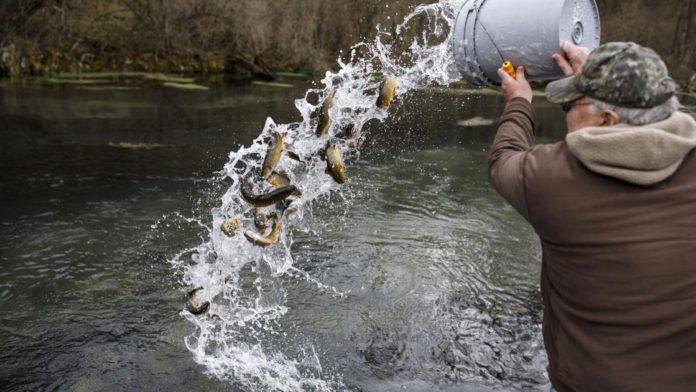Brook trout, the only native species in Pennsylvania, is a state fish, a symbol of wildlife and clean water, and is extremely struggling.
Climate change, the disappearance of hemlock tree shadows from invading insects, and pollution are projected to eliminate colorful fish in most parts of Pennsylvania over the next 50 years.
In addition to these fateful threats, the Pennsylvania Fish and Boat Commission stores non-native and overwhelming hatchery trout in streams used by wild brook trout, says the Pennsylvania Chapter of the Native Fish Union. ..
“This is the full coverage to save this species,” says fly-fishing trout enthusiast and Hershey physician Jim Slesky.
At the heart of the group’s claim is that the Commission stores non-native brook trout and rainbow trout raised in the hatchery in waters where the fish in the hatchery can invade, extrude and eat. It is irreparably damaging to the last fort of wild brook trout. Defeat them for them and food.
“We’re not advocating anything from the left fielders here. It’s happening elsewhere,” said Philip, chairman of the Pennsylvania branch of the Native Fish Union and a resident of Bedford. Lights add.
With an ongoing petition change.org (Lanc.news/brooktrout), the group urges the Fish and Boat Commission to end the practice of storing water in the presence of wild native brook trout. To date, we have over 1,500 signatures.
The petition cites 39 studies showing that the interaction of wild brook trout with hatcheries and even wild alien trout is harmful not only to brook trout but also to aquatic ecosystems.
For example, a study by the Minnesota and Wisconsin Natural Resources Agency found that more aggressive brown trout took over the preferred resting place for brook trout, ate brook trout larvae, monopolized brook trout spawning grounds, and made brook trout susceptible to disease. I found out that
Studies have also suggested that brown trout push brook trout out as climate change warms stream temperatures to marginal levels at which trout can survive.
In another study, brook trout were monitored before and after the brown trout was removed from the middle. After the brown trout were expelled, the brook trout increased in number, grew larger, and survived longer.
“Attempts to increase brook trout populations through flood reduction and habitat improvement management practices are only effective if brown trout are also managed,” the study concluded.
A study by scientists at Missouri State University found that breeding non-native trout could destroy not only brook trout, but also the stream ecosystem. This is because amphibians, including the endangered Hellbender in Pennsylvania, essentially recognize the scent of chemicals emitted by predators and swim and hide.
However, even with the introduction of trout such as brown and rainbow, it did not evolve, so it is less vigilant and more likely to be eaten.
Some of the comments on the petition were from residents of Washington County: In the name of nature maintenance, it’s not scary to release the same fish in a stream where our native chars still exist to please the littering and destructive weekend warriors. “
Indeed, the Chief Executive of the Fish and Boat Commission strongly opposes the damage to brook trout from the 4,600-mile stream release. Dave Nihart, head of the agency’s fisheries management department, said he does not stock waters with high brook trout populations.
He called the use of brook trout into 980 miles of water “unrealistic” and “many wild trout in streams where recreational trout would not be fished if not released. We take pride in providing trout fishing opportunities while conserving our resources. “
He suggested that efforts to save brook trout should be united around creating better river habitat conditions.
“It is not necessary to eliminate hatchery trout breeding in all waters where wild brook trout are present, and it does not improve the quality of wild brook trout populations present in these sections.”
Wright and Thresky couldn’t dispute any more. The Commission’s position does not consider how far brown and rainbow trout will move to invade the waters of brook trout. They also say that brook trout need and do not allow the use of fertile water where stockings occur except in the warmest seasons.
In short, the Commission is doing good to improve the quality of trout flow throughout the state, but believes that its primary mission is not to protect, but to meet the recreational wishes of anglers. They say they are
Wild brook trout resources.
“The release of trout is a state-owned social program governed by politics, not science,” says Suleski. “These trout are political pork to entertain people, not to protect the ecosystem.”
The group wanted the petition to get more signatures so far. And we know that the story of reducing the number of trout in put-and-take hatcheries confuses many anglers.
However, Suleski and Light believe that more fishermen will be involved once they understand what is really happening.
Too many anglers believe that the release of streams and trout lives in peace and harmony and occupies their niche, they say. “The discussion is always organized from an angler’s satisfaction level, not from an ecological point of view,” says Suleski. “For anglers, humans do not always make the best decisions about what we want,” Wright adds.
“We are witnessing a quiet genocide in our state,” says Suleski.
— AdCrable is LNP | Lancaster Online Outdoor Writer.Please email him acrable@lnpnews.com..
Trout War: The group wants to end the stock of hatchery trout on top of wild brook trout | Local News
Source link Trout War: The group wants to end the stock of hatchery trout on top of wild brook trout | Local News
Credit: Source link































